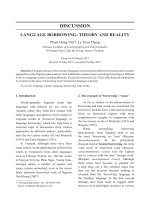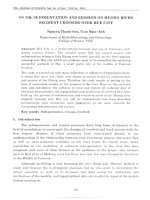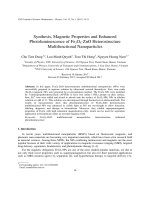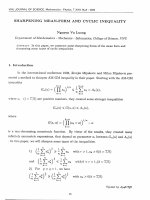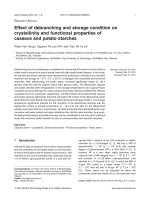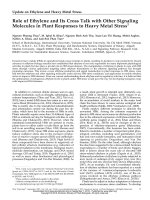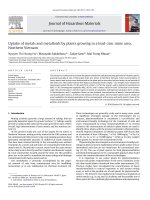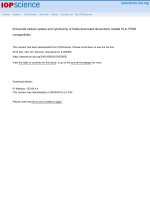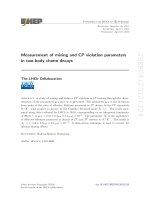DSpace at VNU: Mathematical Uncertainty Relations and their Generalization for Multiple Incompatible Observables
Bạn đang xem bản rút gọn của tài liệu. Xem và tải ngay bản đầy đủ của tài liệu tại đây (267.81 KB, 6 trang )
VNU Journal of Science: Mathematics – Physics, Vol. 33, No. 1 (2017) 29-34
Mathematical Uncertainty Relations and Their Generalization
for Multiple Incompatible Observables
Nguyen Quang Hung*, Bui Quang Tu
Faculty of Physics, VNU University of Science, 334 Nguyen Trai, Hanoi, Vietnam
Received 25 January 2017
Revised 18 February 2017; Accepted 20 March 2017
Abstract: We show that the famous Heisenberg uncertainty relation for two incompatible
observables can be generalized elegantly to the determinant form for N arbitrary observables. To
achieve this purpose, we propose a generalization of the Cauchy-Schwarz inequality for two sets
of vectors. Simple consequences of the N-ary uncertainty relation are also discussed.
Keywords: Generalized uncertainty relation, Generalized uncertainty principle, Generalized
Cauchy-Schwarz inequality.
1. Introduction
The uncertainty principle was introduced by Heisenberg [1] who demonstrated the impossibility of
simultaneous precise measurement of the canonical quantum observables ˆx (the coordinate) and ˆp x
(the momentum) by positing an approximate relation x px
, where
is the Plank constant. A
year after Heisenberg formulated his principle, Weyl [2] derived the more formal relation x p 2 .
ˆ and Bˆ :
Robertson [3] generalized the Weyl’s result for two arbitrary Hermitian operators A
A B
1 ˆ ˆ
[ A B ]
2i
(1)
ˆB
ˆ ] represents the commutator
where A and B are the standard deviations and [ A
ˆB
ˆ ˆ BA
ˆ ] AB
ˆ ˆ . The Robertson formula (1) has been recognized as the modern Heisenberg
[A
uncertainty relation.
Going further, Schrödinger [4] derived the following stronger uncertainty relation:
2
2
1 ˆ ˆ
ˆ Bˆ 1 [ A
ˆ Bˆ ]
A B { A
B} A
2
2i
_______
Corresponding author. Tel.: 84-904886699
Email:
29
(2)
N.Q. Hung, B.Q. Tu / VNU Journal of Science: Mathematics – Physics, Vol. 33, No. 1 (2017) 29-34
30
The difference between Eqs (1) and (2) is the first squared term under the square root, analogously
known as the covariance in the theory of probability and statistics, consisting of the anti-commutator
ˆB
ˆB
ˆ ˆ BA
ˆ B
ˆ } , defined as { A
ˆ } AB
ˆ ˆ , and the product of two expectation values A
ˆ . These
{A
extra terms lead to substantial differences between the two uncertainty relations (1) and (2) in many cases.
All uncertainty relations mentioned above are binary, that means only two observables are involved in
such relations. In this article, we propose a novel generalized uncertainty relation in which N
arbitrary observables simultaneously participate. In order to achieve this goal, we need to establish
new generalized Cauchy-Schwarz inequality.
The paper is organized as follow. In section 2, we introduce notation and derive the Robertson and
Schrödinger uncertainty relations. In section 3, we propose a generalization of the Cauchy-Schwarz
inequality and subsequently formulate a novel uncertainty relation for arbitrary incompatible
observables. Section 4 is devoted to present simple consequences of the generalized uncertainty
relations presented in previous section. Finally, in section 5 we briefly discuss related results and conclude.
2. Mathematical derivation of Schrödinger uncertainty relation
Throughout this article we consider a certain physical state (in a Hilbert space ), all
ˆB
ˆ Cˆ … act on that state, and all observables are assumed to be Hermitian operators. For
observables A
ˆ we define the expectation (which depends on ):
each operator A
ˆ A
ˆ , the operator
A
ˆ , the variance or the
ˆ defined by A
ˆ A
ˆ A
ˆ Id , the associated vector is given by A A
A
dispersion
ˆ:
A
of
ˆ )2 A
ˆ2 A
ˆ
( A )2 ( A )2 ( A
ˆ B
ˆB
ˆ ] [A
ˆ ] . The symmetrized covariance
[ A
ˆB
ˆ ˆ BA
ˆ B
ˆ ) 1 AB
ˆˆ A
ˆ Cov( B,A
ˆ ˆ ).
Cov( A
2
of
2
ˆ
A
.
One
and
Bˆ
easily
can be
finds
that:
defined as:
In an inner product space, the Cauchy-Schwarz inequality states that for any vectors u and v
u 2 v 2 u v 2 the equality holds if and only if u v for some complex .
(3)
On another side, the imaginary and real part of A B can be calculated as
Im A B
A B B A
2i
A B B A
ˆ B
ˆ
ˆ B
ˆ A
A
2i
1 ˆ ˆ
[ A B ]
2i
ˆB
ˆ}
{A
ˆ B
ˆ Bˆ )
ˆ Cov( A
A
2
2
Combining (3), (4) and (5) we obtain the following inequality:
Re A B
(4)
(5)
( A )2 ( B )2 A 2 B 2 A B 2 ( Re A B )2 ( Im A B )2 , or
2
1 ˆ ˆ
ˆ Bˆ 1 [ A
ˆ Bˆ ]
( A ) ( B ) { A
B} A
2i
2
2
2
2
(6)
N.Q. Hung, B.Q. Tu / VNU Journal of Science: Mathematics – Physics, Vol. 33, No. 1 (2017) 29-34
31
2
1 ˆ ˆ
( A ) ( B )
[ A B ]
2i
2
2
(7)
The inequalities (6) and (7) are exactly the Schrödinger and Robertson uncertainty relations,
respectively. Equality in (6) holds if and only if A s B for some s C (complex number),
while equality in (7) holds if and only if A s B for some s i R (imaginary number).
Uncertainty relations also apply to the case of mixed states. The Robertson uncertainty relation for
mixed state can be easily found [5]:
A B
1
ˆ Bˆ ])
Tr( [ A
2i
(8)
where is the density operator that describes the mixed state and Tr denotes the trace. Similarly, the
Schrödinger uncertainty relation for mixed state follows [5]:
2
2
1
ˆB
ˆ )Tr( Bˆ ) 1 Tr( [ A
ˆ Bˆ ])
ˆ }) Tr( A
( A )2 ( B )2 Tr( { A
2
2i
(9)
3. Uncertainty relations in multiple simultaneous measurements
As we have seen in previous section, the Cauchy-Schwarz inequality (3) is the mathematical
foundation of the Heisenberg uncertainty relation (7). In this section, we first propose a novel
generalized Cauchy-Schwarz inequality for multiple vectors, and subsequently, using this inequality
we formulate a generalized uncertainty relation for multiple incompatible observables.
Consider two sets of m and n complex vectors from a Hilbert space H : X { x1 x2 … xm }
and Y { y1 y2 … yn } . We introduce the following 4 complex matrices:
x1 x1
M( X )
xm x1
x1 y1
M ( XY )
xm y1
y1 y1
x1 xm
M(Y )
yn y1
xm xm
y1 x1
x1 yn
M ( YX )
yn x1
xm yn
y1 yn
,
yn yn
y1 xm
yn xm
(10)
(11)
We are able to prove the following determinant inequality [6]:
Theorem 1. Suppose that the matrix M(Y ) is invertible. Then we have the inequality:
det M( X ) det[ M( XY ) M(Y )1 M(YX )]
(12)
The equality holds if and only if X is linearly dependent or X A Y for some matrix A of
size m n .
In the particular, if m n we get the following form:
det M( X ) det M(Y ) det M(YX ) 2
(13)
N.Q. Hung, B.Q. Tu / VNU Journal of Science: Mathematics – Physics, Vol. 33, No. 1 (2017) 29-34
32
We remark that for m n 1 , the inequality (12) becomes: x 2 y 2 x y 2 , which is the
Cauchy-Schwarz inequality (3). For this reason, we shall refer to the inequality (12) as “generalized
Cauchy-Schwarz inequality”.
For two sets of Hermitian operators Xˆ { ˆx ,xˆ , ,xˆ } and Yˆ { ˆy , ˆy , , ˆy } , there are two sets
1
2
m
1
2
m
of associated vectors X { x1 x2 … xm } and Y { y1 y2 … yn } , defined as in
previous section. Following the inequality (12), the natural generalized uncertainty relation for m n
observables { ˆx1 ,xˆ 2 , ,xˆ m ˆy1 , ˆy2 , , ˆyn } should be:
det M( X ) det[ M( X Y ) M( Y )1 M( Y X )]
(14)
Uncertainty relations for mixed states can be derived in a similar way. Below we consider
particular interesting cases, for several observables.
1. Three Observables m 1 n 2 :
For Xˆ { ˆx } and Yˆ { ˆy ˆz } , the uncertainty relation (14) becomes ternary:
( x y z )2 ( x )2 | y z |2 ( y )2 | z x |2 ( z )2 | x y |2
2 Re x y y z z x .
(15)
We remark that the inequality (15) is stronger than inequality (7) which is the Robertson
uncertainty
relation.
2
Indeed, | Re x y y z z x | | x y y z z x | ( x y z ) , then (15) is
stronger than:
3( x y z )2 ( x )2 | y z |2 ( y )2 | z x |2 ( z )2 | x y |2 ,
(16)
which can be easily derived from the Robertson uncertainty relation.
2. Four Observables m 2 n 2 :
For Xˆ { ˆx1 , xˆ 2 } and Yˆ { ˆx3 , ˆx4 } , Eq. (14) forms a quaternary uncertainty relation:
( x x
1
2
)2 | x1 x2 |2 ( x3 x4 )2 | x3 x4 |2
| x1 x3 x2 x4 x1 x4 x2 x3 |2 .
(17)
We need to note that the inequality (17) is stronger than the estimation derived from the Robertson
uncertainty relation for two pairs of operators ( ˆx1 ,xˆ 2 ) and ( ˆx3 ,xˆ 4 ) , which has zero lower bound:
( x x
1
2
)2 | x1 x2 |2 ( x3 x4 )2 | x3 x4 |2 0.
(18)
3. Five Observables m 3 n 2 or m 4 n 1 :
Inequality (14) leads to the same relations as for three and four observables.
4. Applications
The uncertainty relation (14) can be used in different areas of quantum physics. Below, for
simplicity, we limit to several consequences of the generalized uncertainty relation in quantum
mechanics and noncommutative quantum fields.
N.Q. Hung, B.Q. Tu / VNU Journal of Science: Mathematics – Physics, Vol. 33, No. 1 (2017) 29-34
33
A. Consider three incompatible components of angular momentum. Their commutators read [5]:
(19)
[ Jˆ ,Jˆ ] i Jˆ , [ Jˆ ,Jˆ ] i Jˆ , [ Jˆ ,Jˆ ] i Jˆ .
1
2
3
2
3
1
3
1
2
The uncertainty relation (15) takes the form:
( J 1J 2 J 3 )2 ( J 1 )2 J 2 J 3 2 ( J 2 )2 J 3 J 1 2 ( J 3 )2 J 1 J 2 2
2 Re J 1 J 2 J 2 J 3 J 3 J 1
2
( J
4
1
)2 J 1 2 ( J 2 )2 J 2 2 ( J 3 )2 J 3 2
(20)
2 Re J 1 J 2 J 2 J 3 J 3 J 1
Following (16) the weaker estimation of (20) has the form:
( J 1J 2 J 3 )2
2
12
( J
1
)2 J 1 2 ( J 2 )2 J 2 2 ( J 3 )2 J 3 2 .
(21)
We note that in eigenstates of the operators J 3 and J 2 , both sides of (21) are zeros.
B. Consider canonical noncommutative coordinates in a noncommutative space:
[ ˆx ˆy ] i 3 [ ˆy ˆz ] i 1 [ ˆz xˆ ] i 2
(22)
The ternary uncertainty relation (15) becomes:
( xyz )2 2C( xˆ ˆy )C( ˆy ˆz )C( ˆz xˆ )
2
4
12
2
4
( x )2
22
2
4
C( ˆy ˆz ) 2 ( y )2
( x )2 12 ( y )2 22 ( z )2 32
3
3
8
2
2
C( xˆ ˆy ) C( ˆy ˆz ) C( ˆz xˆ )
32
2
4
C( ˆz xˆ ) 2 ( z )2
C( xˆ ˆy ) 2
1 23
(23)
ˆB
ˆ ˆ ) Cov( B,A
ˆ and Bˆ .
ˆ ) Cov( A,B
ˆ ˆ ) the symmetrized covariance of A
where C( A
C. Similarly, consider canonical noncommutative space with four coordinates satisfying
[ ˆx j ˆx k ] ic jk for j k 1… 4 and c j ,k are real, the quaternary uncertainty relation (16) reads:
( x1x2 x3 x4 )2 2 Re x1 x3 x3 x2 x2 x4 x4 x1
2 2
2 2
2
c12
c34 c13
c24 c142 c23
16
(24)
5. Conclusion
In this article, we have proposed a novel uncertainty relations for N ( N 2 ) incompatible
observables. The uncertainty relations for three and four observables have been derived explicitly,
which have been shown stronger than the ones derived from the Schrödinger (or Heisenberg) binary
uncertainty relations. Moreover, we have formulated a determinant form of N -ary uncertainty relation
for arbitrary N incompatible observables. Our results have been derived from generalizing the
classical Cauchy-Schwarz inequality. Alternative stronger uncertainty relations for multi observables,
their associative lower bounds and minimal states have been investigated recently [7-10]. These
34
N.Q. Hung, B.Q. Tu / VNU Journal of Science: Mathematics – Physics, Vol. 33, No. 1 (2017) 29-34
uncertainty relations, based on different inequalities, are not equivalent to the one discussed in this
article. The differences of such uncertainty relations and the corresponding minimal states will be
analyzed in details elsewhere.
References
[1] W. Heisenberg, "Über den anschaulichen Inhalt der quantentheoretishen Kinematik und Mechanik", Z. für Phys.
43, 172-198 (1927).
[2] H. Weyl, "Gruppentheorie Und Quantenmechanik", Hirzel, Leipzig, (1928).
[3] H.P. Robertson, "The uncertainty principle", Phys. Rev. 34, 163-164 (1929).
[4] E. Schrödinger, "Zum Heisenbergschen unschärfeprinzip", Sitzungsber. K. Preuss. Akad. Wiss., 296-303 (1930).
[5] L.E. Ballentine, "Quantum Mechanics: A Modern Developments" (World Scientific, Singapore, 1998).
[6] Sonnet Hưng Q Nguyen, Tú Q. Bùi, "Generalized Noncommutative Uncertainty Principle", VNU-HUS
Science Conf. (2014).
[7] A. Andai, "Uncertainty principle with quantum Fisher information", J. of Math. Phys., 49, 012106 (2008).
[8] S. Kechrimparis, S. Weigerty, "Heisenberg Uncertainty Relation for Three Canonical Observables", Phys.
Rev. A 90, 062118 (2014).
[9] L. Maccone and A. K. Pati, "Stronger Uncertainty Relations for All Incompatible Observables", Phys. Rev.
Lett. 113, 260401 (2014).
[10] L. Dammeier, R. Schwonnek and R.F. Werner, "Uncertainty relations for angular momentum", New J.
Phys. 17, 093046 (2015).
